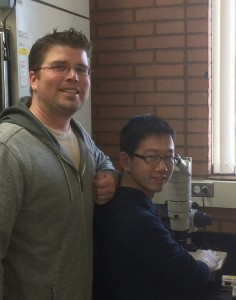Scholars identify new gene
Sean Curran, assistant professor in Biogerontology, and Shanshan Pang, postdoctoral fellow, have identified a gene which allow organisms to adapt to dietary changes, according to their published report in Cell Metabolism.

Dynamic Duo · Assistant Professor Sean Curran (left) and Shanshan Pang (right) utilized a milimeter-long worm to study the new gene. – Akshat Khanna | Daily Trojan
Curran and Pang observed the effects of diet on the lifespan of Caenorhabditis elegans, a millimeter-long worm frequently used as a model organism. The specific gene identified in their study, alh-6, is expressed in a wide range of organisms, ranging from yeast bacteria to humans. Specimens with a mutated alh-6 gene aged prematurely when subjected to a nonstandard diet.
“Although in people we have the same genes, [alh-6], there are small differences, and that’s going to change just slightly how the function works,” Curran said. “I think there’s going to be hundreds more gene-diet pairs to be found. Because [the research] is at the early stages, it’s hard to predict how many there are going to be, or how long it’s going to take.”
Though most students might not necessarily adhere to a strict diet such as veganism or a ketogenic diet, eating to promote good health seems to be a common goal.
“I just subscribe to a balanced diet,” said Maya Barnes, a junior majoring in business administration. “You want to eat proteins and good fats, but that doesn’t mean completely cutting out everything you want to eat.”
Diet can be of particular importance to athletes. It is difficult, however, to empirically gauge the effectiveness of a diet for an individual without going through a process of trial and error.
Zacharie Smith, an undeclared freshman, noted how his commitment to football affects his diet.
“I’m just trying to eat more often throughout the day, eating smaller meals, [eating] fruits and vegetables and trying to stay away from pasta,” he said.
Roberto Yslas, a junior majoring in economics and mathematics and an avid hockey player, echoed Smith’s sentiment.
“I don’t really like the word ‘diet’ — I prefer the word ‘nutrition,’ Yslas said. “I choose foods that will fuel my body and the good thing is I happen to find that those things taste good too.”
Curran envisions a future in which individuals can be matched together with their optimal diets.
“Instead of having to trial-and-error test a diet, we eventually can just make correlations and clinically test specific genetic backgrounds and specific diets, and see if those combinations work,” Curran said. “Now, we live in an era when you can sequence your genome for a thousand bucks. Once we identify more of these gene and diet pairs, when you’re born, you can have your genome sequenced and — based on the genes — we can find your chance of success on this diet or on that diet.”
Barnes noted that she could see a profitable future for personal diet planning.
“I can see [personalized diet planning] becoming successful, because we’ve seen that different kinds of workouts work better for different people, so it would make sense that people metabolize foods differently and with varying levels of success,” Barnes said.
Curran believes that though pairing individuals with genetically compatible diets could improve longevity or lead to weight loss, the primary goal of diet pairing would be to increase quality of life and promote good health.
“If some scientific method does prove that this is going to be better for your sustenance or growth, I don’t think it could hurt,” said Ashima Sharma, a senior majoring in chemical engineering. “I would diet to promote the best health I can get.”
